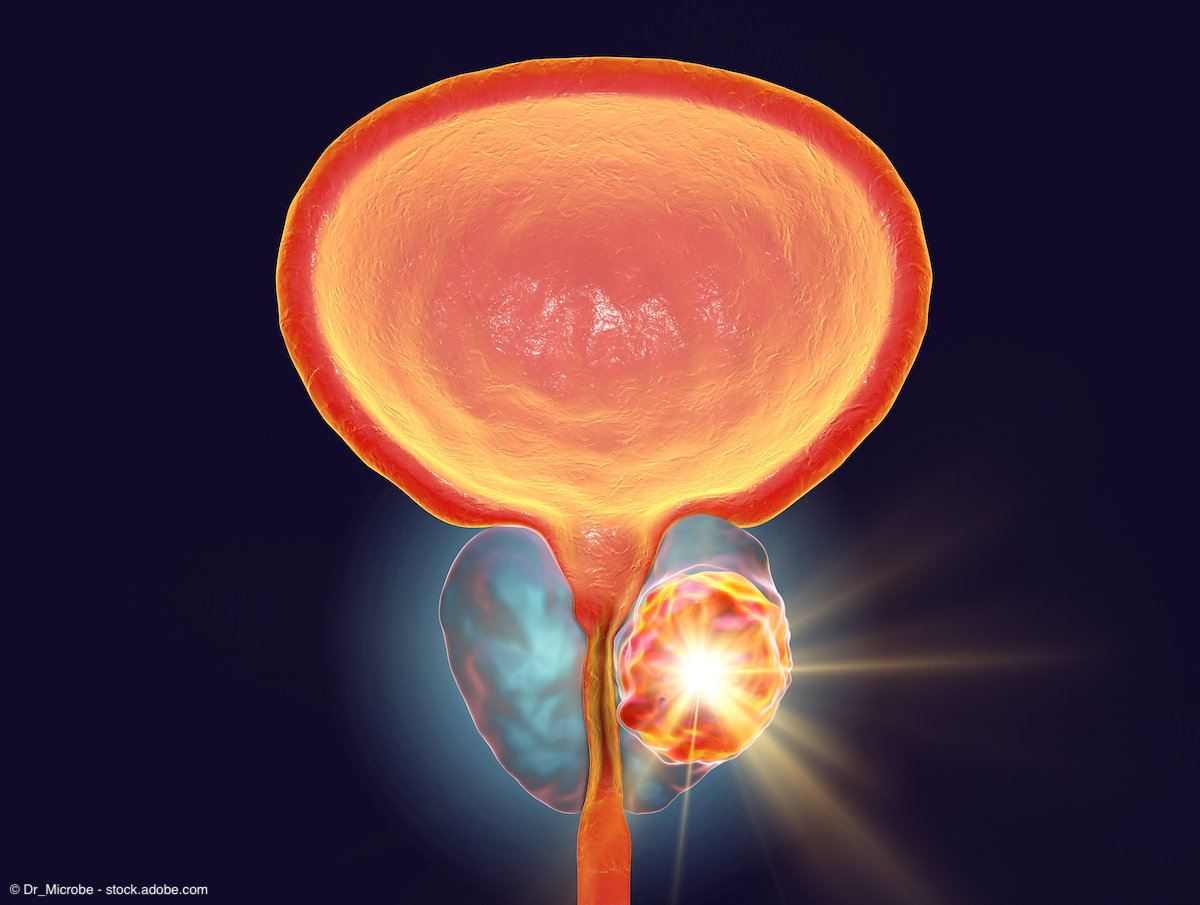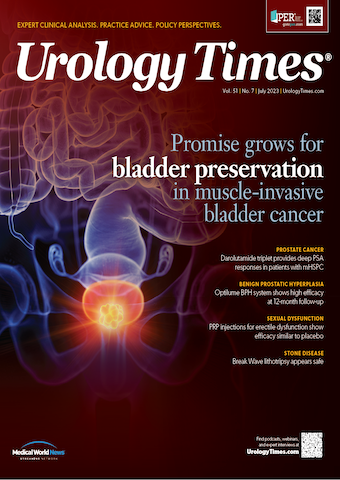Publication
Article
Urology Times Journal
Darolutamide triplet provides deep PSA responses in patients with mHSPC
Author(s):
The deep PSA responses with the darolutamide regimen were found to be correlated with improved overall survival and a prolonged time to PSA progression.
The addition of darolutamide (Nubeqa) to androgen-deprivation therapy (ADT) and docetaxel induced rapid, durable, and deep prostate-specific antigen (PSA) responses in men with metastatic hormone-sensitive prostate cancer (mHSPC), according to a post hoc analysis of the ARASENS trial (NCT02799602) presented at the 2023 AUA Annual Meeting.1
Patients who were treated with darolutamide demonstrated an association between achievement of undetectable PSA at 24 and 36 weeks with improved overall survival.

Such responses were found to be correlated with improved overall survival (OS) and a prolonged time to PSA progression, compared with ADT plus docetaxel alone, supporting the use of PSA response as a prognostic indicator for this patient population.
“Giving docetaxel, ADT, and darolutamide, we've got much better PSA responses. What's most important is that we got much better undetectable PSA responses, which is now our new objective as an early signal that we're doing the right thing and going in the right direction,” Fred Saad, MD, FRCS, chief of urology and director of GU oncology at the University of Montreal Hospital Centers, said in an interview with Urology Times at the AUA meeting.
PSA response
At study entry, median PSA levels were 30.3 ng/mL (range, 0.0-9219.0) for the darolutamide arm and 24.2 ng/mL (range, 0.0–11,947.0) for the control arm.
The darolutamide arm, vs the placebo arm, demonstrated rapid PSA reductions of ≥50% (PSA50) and ≥90% (PSA90) at week 12 (PSA50, 83.7% vs 72.3%, respectively; PSA90, 67.6% vs 42.8%), 24 (PSA50, 89.4% vs 79.7%; PSA90, 82.0% vs 54.4%), 36 (PSA50, 89.6% vs 80.4%; PSA90, 83.7% vs 56.9%), 52 (PSA50, 89.6% vs 80.4%; PSA90, 84.3% vs 57.5%), and any time (PSA50, 89.6% vs 80.9%; PSA90, 84.9% vs 59.0%).
Further, the addition of darolutamide significantly prolonged time to PSA progression, compared with the control arm, at a median of not estimable (NE; 95% CI, NE-NE) and 22.4 months (95% CI, 22.1-27.6), respectively (HR, 0.26; 95% CI, 0.21-0.31; P < .0001).
When evaluating the association between achievement of undetectable PSA at 24 and 36 weeks and time to PSA progression among patients treated with darolutamide, risk was reduced by 72% (HR, 0.28; 95% CI, 0.18-0.42) and 77% (HR, 0.23; 95% CI, 0.15-0.34), respectively, compared with patients who did not achieve undetectable PSA.
Investigators also found that the addition of darolutamide was associated with deep PSA response, compared with placebo (median PSA at nadir, 0.020 ng/mL [range, 0.02-0.25] vs 0.495 ng/mL [range, 0.09-2.85], respectively).
Amongst the deep responses, undetectable PSA was achieved in more than twice the number of patients receiving darolutamide vs placebo at 24 weeks (48.7% vs 23.9%, respectively), which continued to increase at 36 weeks (57.1% vs 25.1%), 52 weeks (60.2% vs 26.1%), and at any time (67.3% vs 28.6%).
Lastly, and most importantly to Saad, patients who were treated with darolutamide demonstrated an association between achievement of undetectable PSA at 24 and 36 weeks with improved OS, reducing the risk for death by 53% (HR, 0.47; 95% CI, 0.35-0.63) and 63% (HR, 0.37; 95% CI, 0.28-0.49), respectively, compared with patients who did not achieve undetectable PSA. In particular, the median undetectable PSA at 36 weeks was NE (95% CI, NE-NE) and 33.3 months (95% CI, 29.3-NE), respectively, reducing the risk for death by 63% (HR, 0.37; 95% CI, 0.28-0.49).
“This is going to be our new challenge: What do we do in these patients that don't get better within 6 months?” Saad added. “This is our new strategy for clinical trials. Should we further intensify? They're already getting a triplet, what can we add? What is making it that they are not getting to undetectable?”
ARASENS trial background
In the ARASENS trial, investigators randomized 1306 patients with mHSPC 1:1 to receive either 600 mg darolutamide twice daily or matching placebo in combination with ADT and docetaxel.2
OS served as the primary end point. Secondary end points included Time to castrate-resistant prostate cancer, time to pain progression, symptomatic skeletal-related event (SSE)-free survival, time to first SSE, time to initiation of subsequent systemic antineoplastic therapy, time to worsening of disease-related physical symptoms, time to initiation of opioid use for ≥7 consecutive days, and safety.
As of the data cut-off date of October 25, 2021, the addition of darolutamide significantly reduced the risk for death by 32.5% (HR, 0.68; 95% CI, 0.57-0.80; P < .0001), compared with ADT plus docetaxel. Further, the incidence of treatment-emergent adverse events was similar between the darolutamide group and the placebo group.
Investigators measured serum PSA at screening, and every 12 weeks after. The exploratory analysis evaluated PSA responses (undetectable PSA, <0.2 ng/mL for 2 samples ≥3 weeks apart) and PSA50 and PSA90 at 12, 24, 36, and 52 weeks and any time during treatment.
Among those in the darolutamide arm, the post hoc landmark analyses evaluated the association between undetectable PSA at weeks 24 and 36 with OS and time to PSA progression (defined as ≥25% increase from PSA nadir nd PSA increase ≥2 ng/mL 12 or more weeks from nadir).
Future direction
To address existing questions around quadruplet regimens in mHSPC, as well as barriers to getting patients to achieve undetectable PSA, Saad noted that clinical trials will be key. “We're going to try to use genomics, use everything we have to try to understand what is that extra therapy? Because we can’t keep doing trials where we just give everything to everybody all the time,” he said. “And I think we're going to take a more rational approach to what we decide to give. And these patients that are not getting great responses must have something that's driving the tumor that's making it upfront resistant.”
Similarly, he added that umbrella trials will be the next step in evaluating treatment options for this patient population. “We need to start doing umbrella trials where we take patients and then we start putting them into [trials] and see if we can we get from detectable to undetectable and say, ‘Okay, well this is maybe a way we should be designing other phase 2, phase 3 studies.’ And we're doing these umbrella trials, we're trying to look for signals.”
References
1. Saad F, Tombal B, Hussain M, et al. Rapid, Durable, and Deep Prostate-Specific Antigen Response Following Addition of Darolutamide to Androgen-Deprivation Therapy and Docetaxel in ARASENS. J Urol. 2023;209(4):e380. doi:10.1097/JU.0000000000003257.01.
2. Smith MR, Hussain M, Saad F, et al. Darolutamide and Survival in Metastatic, Hormone-Sensitive Prostate Cancer. N Engl J Med. 2022;386:1132-1142. doi:10.1056/NEJMoa2119115.



























